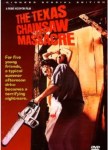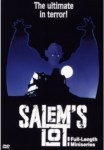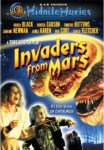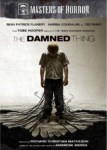by Anthony C. Francis
In the pantheon of great horror directors many names stand tall such as Tod Browning, Val Lewton, Terrence Fisher, George A. Romero, Dario Argento, John Carpenter, etc. They are kings of horror and their respective bodies of work are full of classics that are toasted time and time again. Most of them have near perfect filmographies with only one or two lesser films. One name that is not spoken near enough is that of the great Tobe Hooper. While he is appreciated and respected for his ground breaking classic The Texas Chainsaw Massacre, he is considered to have “fallen from grace” as he has never recaptured the brilliance of that macabre classic. It is true that he never made another film as brilliant and frightening as Chainsaw, which is my third favorite horror film of all time behind The Exorcist and John Carpenter’s Halloween, but this does not mean he never delivered another good scare film. In fact, he has made more than a few great films that have seen varied degrees of success but are proof that Hooper is alive and well in the horror game.

His follow up to the massive success of TCM was not well received but was still a good film. Eaten Alive was another twisted, darkly comic, violent trip through the macabre. Neville Brand stars as a man, who could be a descendant of the family from Chainsaw, who runs a hotel where his pet crocodile resides under the porch and disposes of the guests who are unfortunately lined up as murder victims merely by staying there. As with his previous film, Hooper gives this a gritty, creepy, feel. The murders are brutal and the humor is dark. Brand does what he did best and plays the mental unstable man to the hilt. He and the film entire are marvelous. It is now considered one of the director’s better works with Tarantino singing its praises, but upon its release it did not play well and received mostly negative reviews. This was the first instance of Hooper’s disgust with interference from producers. It is reported that he left the film in its final weeks of production.
Hooper followed that film, or tried to, with a curio called The Dark. This was a strange sci-fi/horror film about an alien life form on earth wreaking havoc. It started out as a zombie film but producers stepped in and turned it to sci-fi. This caused Hooper to leave the production in the first week. He was starting to get a bad reputation, as this was the second time in a row he fought producers and left a film. Worries were that he was a “one hit wonder.”

The next film was the great scare fest, The Funhouse. It was, in my opinion, one of his top three films. It told the story of two couples who spend the night in a carnival’s funhouse as a dare. As in the best horror films, there is a real monster in the funhouse and they must survive the night. However, the film is more than that. It is another example of Hooper’s twisted, darkly comedic, edge as a filmmaker. The great character actor Kevin Conway plays three roles as carnival barkers and gives the film’s creepiest performance. The set design is spot on as he uses dark reds and minimal lighting to induce our fear. This was the first time Hooper filmed in anamorphic Panavision which added to the great look of the film. There are a few homages to films such as Frankenstein, Psycho, and John Carpenter’s Halloween scattered throughout. From the opening moments Hooper scares us and we are on edge for the rest of the film. Here he was working to his potential. No intrusive producers and, again, he delivered the film on time and budget. The film received good notice from critics and turned a small profit at the theaters. However, and I will never understand this, the film was not considered successful. This was, most likely, due to the huge success of Salem’s Lot. Everyone wanted him to have another. The Funhouse was budgeted around 3 million and took in over 7 million at the U.S. box office. It was profitable and is considered by some to be a minor classic of the horror genre but Tobe Hooper does not get proper credit for this film.
In 1981 Hooper was to direct the horror thriller Venom starring a brilliant cast that included Nicol Williamson, Oliver Reed, and Klaus Kinski. Filming was to begin in London but, during pre-production, Hooper left the film due to creative differences with some of the cast and, once again, the producers. This freed him for what was to be his biggest success yet one that would be attributed more to the producer, Steven Spielberg.
Poltergeist is one of the all-time classic horror films. A box office smash in 1982, it went to the forefront of haunted house films and took its place in both pop and horror culture. For the story of a family whose young daughter is tormented by ghosts, producer and co-writer Steven Spielberg turned to Tobe Hooper and together they made a true financial monster. The reviews were great, the film was one of the top 10 box office hits of the year, and Hooper was even nominated for a Saturn Award as Best Director. This was his step into the big time Hollywood film world.
However, once again, Hooper would not fully receive the credit he deserved. For years, Hollywood insiders would say that it was Spielberg who really directed the film. Members of the cast have said how great it was to work with Hooper and how efficient he was as a director but that it was Spielberg who had the creative control and final say. The film’s composer, Jerry Goldsmith, was quoted as saying that he “worked with Spielberg 99 percent of the time.” When the film is talked about these days, most of the credit goes to Spielberg and not to Hooper. Both Hooper and Spielberg have stated that the film was a total collaboration between the two filmmakers. Whatever the case, the film is credited as directed by Tobe Hooper and as such is a horror classic and a masterfully directed film. It shows that Hooper can work well with a big budget film and should have had the chance to do many more.
The next film, for better or worse, was the space vampire film Lifeforce, the first film honoring a three picture deal with Cannon Films. The story of its production is quite messy. The film went through cast changes, script re-writes, budget issues, and when filming was completed, massive cuts and re-editing. Once again Tobe Hooper was burdened with a film that was sabotaged from within resulting in it being a massive failure that received poor reviews and is now largely considered a campy mess. The film is far from perfect but has some good moments, a great score by Henry Mancini, great special effects, and some solid scares. The film was cut by more than 40 minutes and re-edited without Hooper’s involvement. I would like to see his cut, as I am sure it is more structurally sound than the final release. Again, the film has merit and is enjoyable but failed miserably and Tobe Hooper received the full blame.

The Texas Chainsaw Massacre 2 was a great idea that imploded on itself. Hooper wanted to go for less horror and more macabre humor going so far as to refer to the film itself as his only comedy. He felt that the comedy in the original film had been lost amidst the excessive violence. Once more he had a winning team in place with Jim Seidow returning as the family patriarch, Tom Savini doing the effects, Dennis Hopper starring, and Bill Moseley blasting onto the screen in a (cult) star making role as Chop Top. The budget was small but bigger than the original and Hooper was returning to the story that made him. The film made a nice amount at the box office and recouped its budget but was misunderstood by critics and audiences and was considered a failure at the time. This is another undeserving incident, as I find the film to be a raucous good time. It is very funny and creative with gruesome effects, good dialogue, and fun over the top performances. It was everything Hooper promised it to be and, in my opinion, he delivered.
After the failure of all three of the Cannon films, Tobe Hooper began his downward spiral creatively and critically. He did a so-so episode of the TV show Amazing Stories, a blah episode of The Equalizer, and a terrible episode of the terrible show Freddy’s Nightmares. He followed with the two worst films of his career, the astonishingly silly Spontaneous Combustion and the inept mess called The Mangler with Robert Englund. These were followed with a Cannon film called Night Terrors. It barely registered on any level. More sporadic television work and a couple of horrible straight to video movies followed and Tobe Hooper had all but vanished from the horror universe that, in his own time, he helped reshape.
In 2004 Hooper began what I would call a fine comeback. He co-wrote and directed a remake of The Toolbox Murders. The film was a welcome return to form and, I believe, showed that Hooper had not lost his talent for dark humor and good scares. The original film was just a silly film where the killer killed with tools from the titular box. This one is interestingly updated and expanded to a motley crew of dwellers in an apartment building are killed off by someone/thing in the walls. Hooper makes great use of his tight location and peppers his cast with fine character actors led by the underrated Angela Bettis. The humor is dark and funny and the murders are horror movie fun. The film is tight and the director shows he is in control. Sadly, it went straight to video but the quality shows us that it could have played in theaters. It did find an audience on video and, among the horror community, it is respected. It was good news and a welcome return for Hooper.
After the success of Toolbox, Hooper did another straight to video film called Mortuary. It was a creepy film about a family running an old funeral home which stands on haunted ground. The film is successful as a good popcorn horror flick. The buildup is methodical and the payoff scares deliver. It turned a small profit in the video markets and, by now, going straight to video was not the scarlet letter it once was, as many horror films were being marketed to video and bypassing theaters completely. It was a solid scare film and again proved Hooper was coming back.

While his output over the past two decades has been hit and miss it cannot be denied that Tobe Hooper is one of the most underrated of our horror filmmakers. It isn’t fair that he always met with resistance from his producers and many of his films re-edited or finished by others. He shares this burden with another great filmmaker, Sam Peckinpah who consistently fought uphill battles with his producers and studio heads. Years after his death, Peckinpah is regarded as one of cinema’s true geniuses. While I don’t feel that Hooper is a filmmaking genius, he is, in fact, one of the best horror filmmakers working. He has survived bad press and years in television exile.
In the past 5 or 6 years, his reputation is slowly getting better. In 2006 an uncut DVD edition called “The Gruesome Edition” of The Texas Chainsaw Massacre 2 was released with extra footage and commentary by Hooper explaining his true intentions for the tone of the film. The release was well received and saw resurgence in popularity for the film, which is now, officially, a cult classic. In 2002 Hooper directed the pilot for the well-received Spielberg produced miniseries Taken and the following year co-wrote the remake of his own Texas Chainsaw Massacre which became a massive success. This year he has completed his next feature, a paranormal horror film called Djinn. Whether it sees a theatrical release is unknown but it shows that Hooper is still out there.
There have been many articles and documentaries discussing horror films and Tobe Hooper has been interviewed in only a few. He has gone down in history as a director on the outskirts of horror filmmakers despite having directed a few big budget studio films and being one of the groundbreakers of modern horror. For years he has been known as the guy who directed the groundbreaking Texas Chainsaw Massacre, a classic miniseries Salem’s Lot, “some” of Poltergeist, and then faded away. This is unfair and implies he was, basically, a one hit wonder. However, this guy has talent and he has never stopped trying. Yes, there have been hard times but do we give up on Dario Argento or John Carpenter when they haven’t made great films in years? They are consistently referred to as masters of the genre and Hooper should be as well. His mark on horror cinema is forever and he has given us Leatherface, one of the most iconic killers in cinema history in a film that, to this day, is being remade and updated. He frightened television audiences with his supremely faithful adaptation of King’s Salem’s Lot and made another instant horror classic. Controversy aside, he was the director of Poltergeist and helped to make it a worldwide phenomenon. Today he may not have the groundbreakers in him but he is still delivering great horror to fans.
Tobe Hooper is not a man forgotten just a man set aside. He is invited to the big dinner but doesn’t have a seat at the table. In my opinion, he deserves a seat, perhaps not at the head of the table but he should be there and, for me, he is and always will be.








